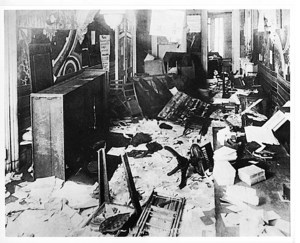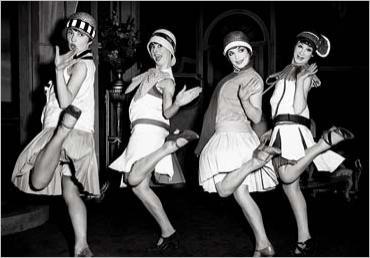
1920s Era

Palmer Raids (Discussion)
Students will be able to argue an assigned point on whether the Palmer Raids were justified and defend their point using evidence collected from a reading assignment passed out to them; following the discussions, students will use the information they gathered through the discussion to compose an extended response to evaluate if the Palmer Raids were justified or not.
Assessments: Students will write an extended response following a discussion on whether the Palmer raids were justified.
Instructional Activities: Teacher will post the question and the requirements on the board for the extended response.
Student Engagement: Students will respond to the question "Were the Palmer raids justified? Justify your answer whether yes or no." in 5-7 complete sentences.
Assessment:Students will participate in a partner discussion with two separate partners.
Instructional Activities: Teacher will provide students with the articles which will be used as evidence for the discussion. While students are discussing, teacher will walk around the room and write comments on the students' performance, which will be the base for their grade the following day.
Student Engagement: Students will participate in two partner discussions as well as a group discussion about the Palmer raids. They will first discuss with the students who have the same argument side as them to gain further evidence, then will discuss with two partners during class. They will take notes on the discussion which can be used as evidence for their extended response.
Assessment: Thumbs Up, Thumbs down
Instructional Activities: Teacher will pose several questions to the students to check understanding of the topic, and check how opinions have changed based on the discussion.
Student Engagement: Students will either give a thumbs up sign, or a thumbs down sign based on each question, and their personal understanding and opinions.

Prohibition (Simulation)
Students will be able to research the topics that they are assigned, and present on their topics as a group in a well-organized presentation, using visual or audio supplements as necessary. They will collaborate with their group members to present cohesively, and each student will be responsible for completing a research paper on their topic.
Assessments:The students will give a presentation about their research topic with their groups using a visual/audio cue.
Student Engagement: The students will be responsible for preparing the presentations and e-mailing them to the teacher prior to the due date.
Instructional Activities: The teacher will be responsible for passing out scoring guides & organizing the groups based on topics of interest. The teacher will fill out the scoring guide while the students are presenting their information.
Assessments: 3-2-1- The students will be filling out a 3-2-1 at the conclusion of the lesson to share what they have learned, what they have questions about, and what they want the teacher to know.
Student Engagement: Students will fill out guided notes which will assist them in the Prohibition Party on the final day. The 3-2-1 must be turned in prior to exiting the class.
Instructional Activities: Teacher will provide the guided notes & look through the 3-2-1 responses to work on answering the questions that the students have.
Assessment: Each student will be responsible for turning in a 1-2 page double spaced paper about their research topic, including a bibliography of their research.
Student Engagement: Students will be responsible for writing a 1-2 page double spaced paper discussing their research topic. They may assist their group mates, but each person is responsible for their own paper.
Instructional Activities: Teacher will provide a rubric for the student's research paper & will also provide a graphic organizer for organizing thoughts if students want to use it.

Women of the 1920s (Lecture)
Students will be able to analyze the importance of the 19th amendment, and use appropriate vocabulary to formulate an extended response about how the amendment still affects them today.
Assessments: Students will answer questions in the lecture to promote student comprehension.
Instructional Activities: Teacher will provide the lecture as well as the questions and guided notes for the students to follow in the lecture. The lecture questions are provided on the paper.
Student Engagement: Students will follow the lecture with guided notes, and complete the questions written in them at the appropriate times.
Assessments: Students will write an extended journal response to the topic "Why does the 19th amendment still affect us today?"
Instructional Activities: Teacher will provide the question on the board and ample time for students to answer.
Student Engagement: Students will write an extended response to the question in their history journal. It should be thought out and written in 7-10 complete sentences answering the prompt.
Assessments: Students will take a clicker quiz to check understanding.
Instructional Activities:Teacher will post questions on the board, and discuss why answers are what they are to clarify understanding.
Student Engagement: Students will use clickers to respond to the 5 questions on the board, one at a time.

Popular Culture (Primary Source)
Students will be able to analyze primary sources that are from the 1920s era, including pictures, music, and writings, and using these documents, will be able to compose an extended response explaining why the mediums of radio and motion pictures were influential to the popular culture of the 1920s.
Assessment: Students will analyze various primary sources using aworksheet, and participate in a small group discussion on what they observed, reflected, and questioned on each primary source.
Instructional Activities: Teacher will first model the analysis tool for the primary source analysis, and then provide students with the primary source analysis worksheet.
Student Engagement: Students will work together in groups in order to analyze the various primary sources about the 1920s popular culture. They will complete a primary source engagement worksheet for each source separately, in order to observe, reflect, and question the sources.
Assessment: Students will compose an extended response, using the primary sources as their evidence for how the growth of radio and movies in the 1920s helped expand the popular culture at the time.
Instructional Activities: Teacher will pose the question for the students to answer on how the growth of radio and movies in the 1920s helped expand the popular culture at the time.
Student Engagement: Students will use the primary source analysis worksheets they completed in order to formulate their own extended response of 7-10 sentences minimum, using the primary sources as evidence for their claim on how the 1920s popular culture was changed by movies and radio.
1920s Presidents (Reading)
Students will be able to summarize the similarities and differences of the policies of Warren Harding, Calvin Coolidge, and Herbert Hoover, and organize what they have learned into a Venn Diagram.
Assessment: Close reading activity discussion, which will allow students to participate by giving their questions up, and allow other students to discuss what they believe the answers are to them.
Instructional Activities: Teacher will provide the close reading for the students, as well as the materials.
Student Engagement: Students will participate in a close reading activity where they will read through an article 3 times, each time getting more in depth understanding of the material.
Assessment: Completion of a three circle Venn diagram with a minimum of three points in the contrasting section, two in each of the partner comparisons, and one in the three section overlap. On the outside of the Venn Diagram, after its completion, the students will be expected to write a short paragraph summarizing what they learned about each President’s policies, and what happened during their administration as they learned from the close reading.
Instructional Activities: Teacher will provide a Venn Diagram outline for the students and an example of the extent of the work that is expected.
Student Engagement: Students will complete a the Venn Diagram using the information they gathered in the close reading activity. At the completion of the Venn Diagram, the students will then be expected to write a paragraph summary of each of the presidents' policies and their administration.